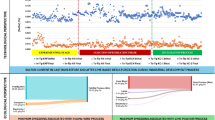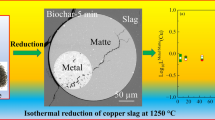Abstract
The efficient and harmless treatment of cyanide tailings is necessary for gold extraction processes. The present study reports the effects of ClO− generation in a slurry electrolysis system containing NaCl on the removal rate of cyanide and heavy metal ions in cyanide tailings. The chemical dissolution of metallic minerals and the reaction mechanisms were investigated by Fourier-transform infrared (FT-IR) and X-ray diffraction (XRD) analyses. The obtained results evidenced the key role of ClO− in the removal of cyanide and heavy metal ions through the slurry electrolysis system with NaCl addition. Furthermore, ClO− formation increased with the NaCl concentration, resulting in a higher removal rate of cyanide and heavy metal ions and enhanced metallic mineral dissolution. The cyanide tailings showed the best harmless effect with a NaCl concentration of 15 g/L. With this condition, the removal rates of CNT, CN−, Cu, Zn and Fe were 96.15%, 98.34%, 98.62%, 99.32% and 79.31%, respectively; furthermore, Cu and Fe precipitated at the cathode. The relative hematite content decreased by 3.12%. Under the effect of an electric field, the cyanide and metal cyanide complexes in the cyanide tailings oxidised and decomposed to release metal cations by the strongly oxidising ClO− generated at the anode. The metal cations and hematite were reduced at the cathode, while the metal oxide mineral hematite in the electrolyte underwent chemical dissolution. In the toxic degradation of cyanide tailings, the comprehensive recovery of metals and destruction of metallic minerals in tailings will provide favourable conditions for subsequent comprehensive utilisation.










Similar content being viewed by others
Data availability
All data generated or analysed during this study are included in this published article.
References
Agustina F, Bagastyo AY, Nurhayati E (2019) Electro-oxidation of landfill leachate using boron-doped diamond: role of current density, pH and ions. Water Sci Technol. https://doi.org/10.2166/wst.2019.040
Allanore A, Lavelaine H, Valentin G, Birat JP, Delcroix P, Lapicque F (2010) Observation and modeling of the reduction of hematite particles to metal in alkaline solution by electrolysis. Electrochim Acta 55:4007–4013
Bae M, Lee H, Yoo K, Kim S (2021) Copper(Ι) selective chemisorption on magnetite (Fe3O4) over gold(Ι) ions in chloride solution with cyanide. Hydrometallurgy 201:105560
Brillas E, Martínez-Huitle CA (2015) Decontamination of wastewaters containing synthetic organic dyes by electrochemical methods. An up dated review. Appl Catal B Environ 166–167:603–643
Chuanpeng Cui, Ling Chen, Wenxin Du, 2001. FTIR studies on two compounds containing cyanide. Spectrosc Spect Anal 01:104–105
Dominguez CM, Oturan N, Romero A, Santos A, Oturan MA (2018) Lindane degradation by electrooxidation process: effect of electrode materials on oxidation and mineralization kinetics. Water Res 135:220
Dong CF, Xue HB, Li XG, Qi HB, Cheng YF (2009) Electrochemical corrosion behavior of hot-rolled steel under oxide scale in chloride solution. Electrochim Acta 54:4223–4228
Dong K, Xie F, Wang W, Chang Y, Lu D et al (2021) The detoxification and utilization of cyanide tailings: a critical review. J Clean Prod 302:126946
Fa Jardo F, AS, Seca HF, Martins RC, et al. (2017) Phenolic wastewaters depuration by electrochemical oxidation process using Ti/Iro2 anodes. Environ Sci Pollut R 24(8):7521–7533
Ganiyu SO, Dos Santos EV, Cintia TD (2018) Electrochemical advanced oxidation processes (Eaops) as alternative treatment techniques for carwash wastewater reclamation. Chemosphere 211:998–1006
Li H, Li S, Ma P (2021) Evaluation of a cleaner production for cyanide tailings by chlorination thermal treatments. J Clean Prod 281:124195
Ince C (2019) Reusing gold-mine tailings in cement mortars: mechanical properties and socio-economic developments for the Lefke-Xeros area of Cyprus. J Clean Prod 238(1):17871
Jun Wang, Weiliang Chen, Zhiliang Jiao, 2014. Research progress on recovering gold and silver from cyanide residues. Consv Util Miner Rsrc 8:54–58
Liu C, Wu B, Chen Xe (2018) Sulfate radical-based oxidation for sludge treatment: a review. Chem Eng J 335:865–875.
Sun L, Chang Y, Xiaohui Xu (2017) The main technology status and development trend of harmless and resourceful utilization of cyanide tailings. China Rsrc Comp Util 10(59):62
Naje AS, Ajeel MA, Ali IM, Al-Zubaidi HAM, Alaba PA (2019) Raw landfill leachate treatment using an electrocoagulation process with a novel rotating electrode reactor. Water Sci Technol 80:458–465
Nassar R, Rifai A, Trivella A (2018) Aqueous chlorination of sulfamethazine and sulfamethoxypyridazine: kinetics and transformation products identification. J Mass Spectrom 1–10
Neanderson G, Jeanette B, Carlos M (2020) Landfill leachate treatment by electrocoagulation: effects of current density and electrolysis time. J Environ Chem Eng 8:104368
Neodo S, Rosestolato D, Ferro S, Battisti AD (2012) On the electrolysis of dilute chloride solutions: influence of the electrode material on faradaic efficiency for active chlorine, chlorate and perchlorate. Electrochim Acta 80:282–291
Nieto CD, Palacios NA, Verbeeck K (2019) Membrane electrolysis for the removal of Mg2+ and Ca2+ from lithium rich brines. Water Res 154:117–124
Olvera-Vargas H, Gore-Datar N, Garcia-Rodriguez O, Mutnuri S, Lefebvre O (2021) Electro-Fenton treatment of real pharmaceutical wastewater paired with a BDD anode: reaction mechanisms and respective contribution of homogeneous and heterogeneous OH. Chem Eng J 404:126524
Peipei Song, Chengye Sun, Jun Wang, Shiyun Ai, Shujun Dong, Jie Sun, Shuai Sun (2022) Efficient removal of Cu-EDTA complexes from wastewater by combined electrooxidation and electrocoagulation process: performance and mechanism study. Chemosphere 287:131971
Pengyun Yu, Fan Yang, Jianping Wang, 2013. Femtosecond two-dimensional infrared spectroscopy of Fe(CN)64−/Fe(CN)63− in aqueous solution. Sum. Rpt. 13th Nat. Conf. Chem. Kine.
Pillai I, Gupta AK (2016) Anodic oxidation of coke oven wastewater: multiparameter optimization for simultaneous removal of cyanide, cod and phenol. J Environ Manage 176:45–53
Sanshan Li, Chaoqun Zheng, Shunqing Yang, 2020. Reduction of nitrogen and phosphorus loading from polluted sediment by electrolysis. Ecol Eng 106088
Song Yonghui, Qu Xuehua, Wu Chunchen, Lan Xinzhe, Zhou Jun, 2015. Cyanide wastewater with high density copper treated by zinc sulfate precipitation process. Chin J Rare Met 39:356–364
Song Yonghui, Lei Siming, Yin Ning, He Wenjin, 2019. Treatment cyanide wastewater dynamic cycle test by three-dimensional electrode system and the reaction process analysis. Environ Technol https://doi.org/10.1080/09593330.2019.1677783
Choubey Sourav, Prerna Goswami, Shina Gautam, 2021. Recovery of copper from waste PCB boards using electrolysis. Mater Today Proc 42:2656–2659
Wang J, Huang Z, Yang D, Zeng X et al (2021) A semi-scaled experiment for metals separating and recovering from waste printed circuit boards by slurry electrolysis. Process Saf Environ 147:37–44
Wang X, Li C, Zhang B, Lin J, Chi Q, Wang Y (2016) Migration and risk assessment of heavy metals in sewage sludge during hydrothermal treatment combined with pyrolysis. Bioresour Technol 221:560–567
Wanlin Y, Guoshuai L, Yinhao C et al (2020) Persulfate enhanced electrochemical oxidation of highly toxic cyanide-containing organic wastewater using boron-doped diamond anode. Chemosphere 252:126499
Xianwan Yang, Yingjie Zhang, Lunhao Deng, 2000. Leaching mechanism of slurry electrolysis. Eng Sci 002:49–51,58
Yajie Zheng, Chang Gong, Shaoming Sun, 2014. New technology of iron extraction and gold recovery from cyanide tailings by cyanide process after reduction roasting and acid leaching. Chin J Nonferr Met 24:2426–2433
Yaqub M, Woo C, Lee W (2021) Optimization of hypochlorous acid generation by HCl electrolysis through response surface methodology and artificial neural networks. J Environ Chem Eng 9:105826
Yi Chen, Yonghui Song, Yao Chen, Xinwei Zhang, Lan Xinzhe, 2020. Comparative experimental study on the harmless treatment of cyanide tailings through slurry electrolysis. Sep Purif Technol 251:117314
Zambrano J, Min B (2019) Comparison on efficiency of electrochemical phenol oxidation in two different supporting electrolytes (NaCl and Na2SO4) using Pt/Ti electrode. Environ Technol Inno 15:100382
Zeng X, Twardowska I, Wei S, Sun L, Wang J, Zhu J, Cai J (2015) Removal of trace metals and improvement of dredged sediment dewaterability by bioleaching combined with Fenton-like reaction. J Hazard Mater 288:51–59
Zgab C, Yang Z, Hui J, Jga B, Xia MC, Jie W (2021) Electrochemical methods for landfill leachate treatment: a review on electrocoagulation and electrooxidation. Sci Total Environ 806:150529
Zhang J, Liu L, Liang Y (2015) Enhanced precipitation of cyanide from electroplating wastewater via self-assembly of bimetal cyanide complex. Sep Purif Technol 150:179–185
Zhou Y, Zhang Z, Zhang J, Xia S (2016) Understanding key constituents and feature of the biopolymer in activated sludge responsible for binding heavy metals. Chem Eng J 304:527–532
Zhuo QF, Wang JB, Niu JF, Yang B, Yang Y (2020) Electrochemical oxidation of perfluorooctane sulfonate (PFOS) substitute by modified boron doped diamond (BDD) anodes. Chem Eng J 379:122280
Funding
This work was supported by the National Natural Science Foundation of China (51774227), Key Fund of Shaanxi Natural Science Foundation (2018JZ5011) and the Innovation Capability Support Program of Shaanxi (2020TD-028).
Author information
Authors and Affiliations
Contributions
Yi Chen: experiments, data processing and the writing original manuscript; Yonghui Song: supervision; Lei Wu: pre-review and revision; Ping Dong: device support.
Corresponding author
Ethics declarations
Ethics approval
Not applicable.
Consent to participate
Not applicable.
Consent for publication
Not applicable.
Competing interests
The authors declare no competing interests.
Additional information
Responsible Editor: Ioannis A. Katsoyiannis
Publisher's note
Springer Nature remains neutral with regard to jurisdictional claims in published maps and institutional affiliations.
Rights and permissions
About this article
Cite this article
Chen, Y., Song, Y., Wu, L. et al. Role of hypochlorite in the harmless treatment of cyanide tailings through slurry electrolysis. Environ Sci Pollut Res 29, 40178–40189 (2022). https://doi.org/10.1007/s11356-022-18872-1
Received:
Accepted:
Published:
Issue Date:
DOI: https://doi.org/10.1007/s11356-022-18872-1




